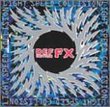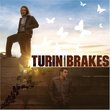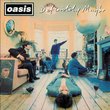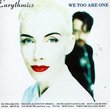| All Artists: Yes Title: Tales From Topographic Oceans Members Wishing: 9 Total Copies: 0 Label: Rhino/Elektra Original Release Date: 1/1/1974 Re-Release Date: 8/26/2003 Album Type: Original recording reissued, Original recording remastered, Extra tracks Genres: Pop, Rock, Classic Rock Styles: Progressive, Progressive Rock, Album-Oriented Rock (AOR) Number of Discs: 2 SwapaCD Credits: 2 UPCs: 081227379124, 081227379162, 4943674063871, 603497984541 |
Search - Yes :: Tales From Topographic Oceans
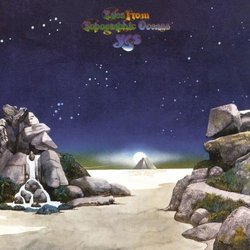 | Yes Tales From Topographic Oceans Genres: Pop, Rock, Classic Rock
Full title - Tales From The Topographic Oceans. 2003 remastered, reissue of 1973 album with redesigned booklet (digipak/slipcase), restored LP art, archival photos and new liner notes. Includes 2 bonus tracks 'Dance Of ... more » |
Larger Image |
CD DetailsSynopsis
Album Description Full title - Tales From The Topographic Oceans. 2003 remastered, reissue of 1973 album with redesigned booklet (digipak/slipcase), restored LP art, archival photos and new liner notes. Includes 2 bonus tracks 'Dance Of The Dawn' (studio run through) & 'Giants Under The Sun' (studio run through). Elektra. Similarly Requested CDs
|
CD ReviewsTales Revisited Lonnie E. Holder | Columbus, Indiana, United States | 03/29/2004 (5 out of 5 stars) "I reviewed the original version of "Tales from Topographic Oceans" back in October 2002. More recently I purchased this expanded two CD version from Rhino that includes not only the original four tracks, but a studio run-through of "Dance of the Dawn" and "Giants Under the Sun." Jon Anderson's vocals sound a bit thready and weak in the studio run-through, and the harmonies have yet to be added, yet, there is a certain charm to these run-throughs and the music is powerful."Tales" is a deeply philosophical album that is not for the meditative faint of heart. While much music is created to be toe-tapping and easy to sing to, "Tales" is in that genre usually called progressive rock, in a sub-genre that requires intense analysis to understand. The result is an album that is inaccessible and incomprehensible to a casual listener. In order to understand this music you must read the lyrics and listen, and listen, and then listen some more. Even then you might fail to gain a glimmer of Yes' intent."Tales from Topographic Oceans" would have to qualify as one of the most if not the most deeply complicated rock music ever created. Again, if you are a casual listener the complexity of the music can be frustrating or boring. However, if you consider that classical music is often complex, and to be understood requires extended focused listening, it should be of little surprise that Yes took that complexity for its own in the development of this music, creating a symphony in four movements.The first movement is titled "The Revealing Science of God: Dance of the Dawn". The lyrics have no meaning, and they also have meaning. Confusing? Oh yeah. Understand that the point of the movement is to get the listener to realize that there are bits and pieces of knowledge, and understanding is something that rarely, if ever, comes all at once. Jon Anderson uses the sound of the words to create an almost subliminal meaning. The whole point is that you are to realize that we do not understand, but we have to keep trying to understand. Also, when you find meaning, know that you found it within yourself.The second movement is "The Remembering: High the Memory". This song is about the breadth of knowledge that is available to humankind and to any one individual. However, the song is also trying to say that while that knowledge is available, each of us can only access that knowledge when it becomes a part of our personal knowledge, and more than just having it as personal knowledge, it must be accessible and understood to be useful. Another way of saying this is that we have realms of knowledge that are potentially available to each of us. However, only that knowledge which we personally understand and can access will be of any value to us.The third movement is "The Ancient: Giants under the Sun". The concept of this song is relatively simple compared to the first two movements. This song pushes through the envelope of recorded time to access forgotten knowledge from civilizations that came before. While the song is relatively easy to understand, the music is more interwoven and complex, and intertwines elements that are intended to evoke those earlier cultures. Therefore, the instruments flavor this movement with musical elements from around the globe to help give the feeling that the song of our knowledge is made up of many parts from many people. While the music sounds relatively simple, it is as technically detailed and complex as any concerto or symphony I can recall. While Steve Howe's guitar may be pivotal in this song according to Jon Anderson, Rick Wakeman's keyboards are essential to the ethnicity of the various portions of the music. This track is an incredible composition. This movement adds to the seeking of the first movement and the understanding of the second movement that there is knowledge yet available to be discovered from all cultures and civilizations that may no longer exist, but that understanding is still available if we know where and how to look for it.The fourth and final movement is "Ritual: Nous Sommes Du Soleil". This composition is relatively accessible philosophically because it is a description of the human condition. This piece is intended to communicate that we have the ability to seek knowledge and understanding. Part of that knowledge and understanding is the constant struggle between good and evil, and how that struggle plays a part of how we view that knowledge. However, this piece also reinforces the earlier movements in that we have the ability learn and to understand granted by a higher power. I've read that Rick Wakeman complained that there was too much filler in this composition. I suppose that could be said of many of the classical compositions by Beethoven, Tchaikovsky, Bach, and on and on. However, I've also read that Steve Howe thought that this was some of his best work ever. This work is magnificent in conception and scope. It is not readily accessible to the casual listener. The very best way to understand this music is to get a bottle of really good wine, sit in the middle of the room in a recliner, turn out most or all of the lights, and listen and feel. Start by paying attention to the emotion and feeling of the words, because that was the intent of the lyrics. Once you begin to understand what was intended, then this work becomes accessible. It is one of the most incredibly complex pieces of music I've ever heard, and I have listened to everything from classical to death metal. This music isn't for everyone, but those who can get into it, it is fantastic." A major work of its time, but now increasingly timeless Gavin Wilson | 11/07/2003 (5 out of 5 stars) "Back in 1973, the target market for this sort of music -- 14 to 22-year-olds, mostly male, academic rather than sporty -- had time on its hands. You need to remember that: 1. There was no Internet. 2. There was no GameBoy, Playstation or other video game. 3. There were just three TV stations (for us in the UK), and they usually closed down before midnight. 4. There was no video-recording medium available at an affordable price.As a teenager at the time, I remember sitting around a lot doing not much!The one artistic medium that the consumer could really control was sound i.e. music, with radio, LPs and the compact cassette working together to enable the listener to enjoy the material whenever he or she wanted. People spent proportionately much more of their income on this one medium than they do now. (Indeed concert tickets at the time typically cost rather less than an LP.) So many artists put a lot of effort to get their recorded output as perfect as possible. Pink Floyd, for example, spent years getting 'The Dark Side of the Moon', also released in 1973, precisely right.Other artists, such as Genesis and Yes, decided for one album each that more effort meant more length. Genesis produced 'The Lamb Lies Down on Broadway', while Yes created the controversial 'Tales from Topographic Oceans'.I had been entranced by Yes, ever since buying a cassette version of 'Close to the Edge' the previous year, purely on the basis of a few colour photos! I had pre-ordered the new double LP from a mail order firm that believed it was called 'Tales from Tobergraphic Oceans'.I have to admit that even in those days, you needed to be a pretty committed fan to defend the album. There weren't enough catchy tunes, and you had to change sides three times to listen to the whole thing. (Thankfully with CD, you only need to change sides once.) We didn't fight or even argue over it -- we just ignored each other's pet favourites, such as Genesis, David Bowie, or the Eagles. (I'm begining to think that what killed the mid-1970s progressive excess wasn't so much Punk Rock, but actually the more accessible, and much shorter tunes written by intelligent US bands such as Steely Dan, Little Feat and the Doobie Brothers.)Topographic Oceans introduced the Yes world to not just Jon Anderson's theological pursuit but also the drumming of Alan White. I feel that was one of the big disappointments of the album, as well as Wakeman's general lack of presence. White was OK at hitting a simple beat on the tom-toms, but he just seemed to lack the jazz-tinged subtlety of Bill Bruford, who helped make CLOSE TO THE EDGE such a five-star classic.Another marketing mistake that Topographic made was not including any photos of the band, an error repeated only on 'Relayer'. Judging by the Roger Dean cover, this was an album for the fish. It was utterly impersonal.After the album and the tour, the band effectively split for several months, with each member creating solo albums -- e.g. Olias of Sunhillow, Fish out of Water, Beginnings. Rick Wakeman split more permanently, to pursue his interest in Jules Verne and King Arthur, returning to make 'Going for the One'.In retrospect, Anderson's musical vision was too grandiose, and the lyrics were of interest to only a tiny portion even of Yes fans. Topographic Oceans can be heard today as a flawed symphony. For the committed Yes fan, it never really flags. Because we know it so well, no track is better than any other, and the whole thing is in many ways a great work.But long gone are the days when you would simply listen to this sort of music with friends -- listening and doing nothing else, besides perhaps looking at the album cover. Nowadays we're so short of time that we play this sort of stuff as background music, while we're working or driving. It's less portentous that it once was, but it's a lot better than silence." Finally a listenable version of Tales Lonnie E. Holder | 09/14/2003 (5 out of 5 stars) "This album is arguably the all time "whipping boy" of progressive rock. Hardcore Yes fans tend to love it and others tend to hate it. Also, due to its length and opulent title/artwork it falls prey to a multitude of Spinaltap-esque jokes.Personally, I love it. Always have. I've owned this on vinyl and now 2 CD masters. This is the FIRST version that I've heard that actually sounds good. Its miraculous what Rhino have done with this. You can actually hear parts on here that were completely lost in the muddiness of previous masters.I've always thought this was strong musically, but some will disagree. If you've already decided you hate this album, you might consider giving it a second shot with this master. The ONLY complaint other than it taking 30 years to have this work properly mastered is that the artwork, while good for a CD remaster - is, well, its the size of a CD obviously. This cover is one of the strongest that Roger Dean did for Yes and it was meant to go on an album obviously - and BIG. I remember this hippy chick I knew bringing this over to the house with about 20 other records back in the 70's. This cover and Anderson's Olias album were two of the wildest things I think I'd ever seen!"
|

 Track Listings (3) - Disc #1
Track Listings (3) - Disc #1

